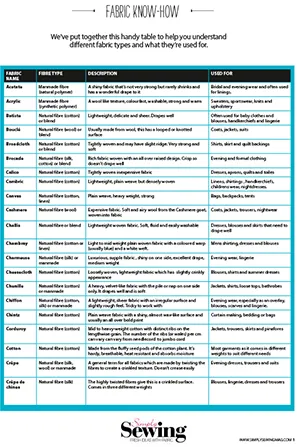While fabric shopping is one of life’s greatest pleasures (FACT), the sheer variety of dressmaking fabric available can sometimes be a tad daunting when you're trying to figure out the right type for your next project.
Start foraging for different fabrics and a world of discovery awaits you, and we’re here to help. We've put together a handy Know Your Fabric guide (first featured in issue 20 of Simply Sewing magazine), featuring some of the most common fabrics – bookmark this page so you can refer to it the next time you're foxed by fabric types.
Which fabric should I use?
Fabrics are made from different types of fibres, either natural or manmade, which influence how they behave. Fabrics can be woven, non woven and knitted, which affects their weight, drape and stretch. To add an extra ingredient into the mix, many fabrics can be bought in different weights, too.
If in doubt, start by thinking about what you want your fabric to do and choose one that suits. For example, if you're making a summer dress then you’ll want something lightweight – we’d suggest a woven, natural fibre such as cotton, which is breathable but has a little synthetic fibre added to give it drape, like Challis.
It’s always good to physically feel and see a fabric before you buy, but with so many tempting online shops out there, you may not get the chance. Read on for your free fabric know-how guide now and you'll be armed with the information you need to always find the perfect fabric.
Download our Free Guide to different types of fabric (PDF)

Beginners Guide to Fabric Types
Acetate
- Description: A shiny fabric that’s not very strong but rarely shrinks and has a wonderful drape to it
- Fibre type: Manmade fibre (natural polymer)
- Use it for: Bridal and evening wear and often used for linings.
Acrylic
- Description: A wool like texture, colourfast, washable, strong and warm
- Fibre type: Manmade fibre (synthetic polymer)
- Use it for: Sweaters, sportswear, knits and upholstery
Batiste
- Description: Lightweight, delicate and sheer. Drapes well
- Fibre type: Natural fibre (cotton) or blend
- Use it for: Often used for baby clothes and blouses, handkerchiefs and lingerie
Batiste
- Description: Lightweight, delicate and sheer. Drapes well
- Fibre type: Natural fibre (cotton) or blend
- Use it for: Often used for baby clothes and blouses, handkerchiefs and lingerie
Bouclé
- Description: Usually made from wool, this has a looped or knotted surface
- Fibre type: Natural fibre (wool) or blend
- Use it for: Coats, jackets, suits
Broadcloth
- Description: Tightly woven and may have slight ridge. Very strong and soft
- Fibre type: Natural fibre (cotton) or blend
- Use it for: Shirts, skirt and quilt backings
Brocade
- Description: Rich fabric woven with an all over raised design. Crisp so doesn’t drape well
- Fibre type: Natural fibre (silk, cotton) or blend
- Use it for: Evening and formal clothing
